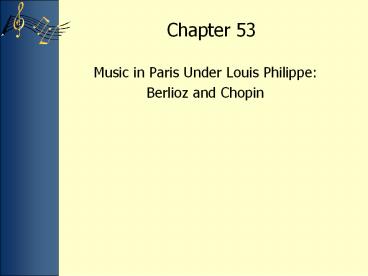Music in Paris Under Louis Philippe: - PowerPoint PPT Presentation
1 / 13
Title:
Music in Paris Under Louis Philippe:
Description:
The subject of this famous painting by Eug ne Delacroix is the July Revolution ... 1840 composes the songs of Les nuits d' t . 1840s tours Germany conducting ... – PowerPoint PPT presentation
Number of Views:185
Avg rating:3.0/5.0
Title: Music in Paris Under Louis Philippe:
1
Chapter 53
- Music in Paris Under Louis Philippe
- Berlioz and Chopin
2
Lecture Overview
- Paris vs. Vienna in the early 19th century
- Hector Berlioz
- life and music
- Symphonie fantastique, movement 4 (March to the
Scaffold) - History of the piano and pianism 1800-1850
- Frédéric Chopin
- life and music
- Nocturne in Db, Op. 27, No. 2
- Review
3
Paris The July Revolution (1830) Delacroix,
Liberty Leading the People
- The subject of this famous painting by Eugène
Delacroix is the July Revolution in Paris in
1830, when the French king Charles X was deposed.
Our eyes are drawn to the female figure at the
top, who symbolizes liberty and strides
fearlessly forward. The tone of the picture is
filled with energy and emotion, which were
qualities also found in French music of the same
time.
4
The Life of Hector Berlioz (18031869)
- 1803 born near Grenoble to the family of a
doctor - 1821 arrives in Paris to study medicine
changes to music - 1830 completes Symphonie fantastique, wins the
Prix de Rome - 1830s becomes a journalist, writes for several
Parisian papers and journals - 1840 composes the songs of Les nuits dété
- 1840s tours Germany conducting his music
- 1869 dies in Paris
5
Principal Compositions of Hector Berlioz
- Orchestra concert overtures programmatic
symphonies including - Symphonie fantastique
- Romeo and Juliet
- Harold in Italy
- Operas including
- Benvenuto Cellini
- The Trojans
- Béatrice et Bénédict
- Chorus works including
- The Damnation of Faust
- Lenfance du Christ
- Requiem Mass
- Songs Les nuits dété (6 songs on poetry by
Théophile Gautier) - Writings Memoirs, essays collected as Evenings
in the Orchestra and A travers chants
6
Symphonie fantastique (1830) The Program
- 1. Reveries Passions. A young musician sees
the ideal woman and suffers fitful passions - 2. A Ball. The obsessive thought of the beloved
returns to him at a ball - 3. Scene in the Country. Even the countryside
cannot allay his passion he suffers doubts about
her - 4. March to the Scaffold. In a nightmare he
believes that he has murdered her, and he is now
to be guillotined for his crime. The blade
falls. . . - 5. Dream of a Witches Sabbath. He awakens in
hell, taunted by witches, and he sees the beloved
among them
7
How Orchestral Music Tells the Story of Symphonie
fantastique
- themes used to symbolize characters in the
program - quotations of pre-existing music
- instruments used to suggest characters and
situations - instruments imitate natural sounds
- musical genres (the march, the waltz) brought in
as suggested by the program - deployment of conventional musical elements
(mode, tempo, character)
8
Hector Berlioz, Symphonie fantastique, 1830,
movement 4 (March to the Scaffold)
Irregular sonata form
9
Hector Berlioz, Les nuits dété, Absence, 1840
Rondo-like form
10
The Life of Frédéric Chopin (18101849)
- 1810 born in Poland, grows up in Warsaw
- 182731 tours Europe as piano virtuoso
- 1831 settles in Paris
- 1837 affair with French writer George Sand
- 1847 breaks up with Sand, health declines
(tuberculosis) - 1848 visits London and Scotland to concertize
- 1849 dies in Paris
11
Chopins Principal Compositions
- Piano character pieces including
- ballades
- nocturnes
- études
- scherzos
- preludes
- polonaises
- mazurkas
- impromptus
- Sonatas for piano (3) and for cello-piano (1)
- Piano concertos (2)
- Songs (most in Polish)
12
Frédéric Chopin, Nocturne in Db Major, Op. 27,
No. 2, 1835
Free rondo form
13
Review Key Terms
- Louis Philippe
- July Revolution
- grand opera
- Giacomo Meyerbeer
- Eugène Scribe
- double escapement
- action
- recital
- Prix de Rome
- concert overture
- programmatic symphony
- idée fixe
- cyclicism
- ophicleide
- song collection
- romance (type of song)
- mélodie
- George Sand
- mazurka
- nocturne
- étude































